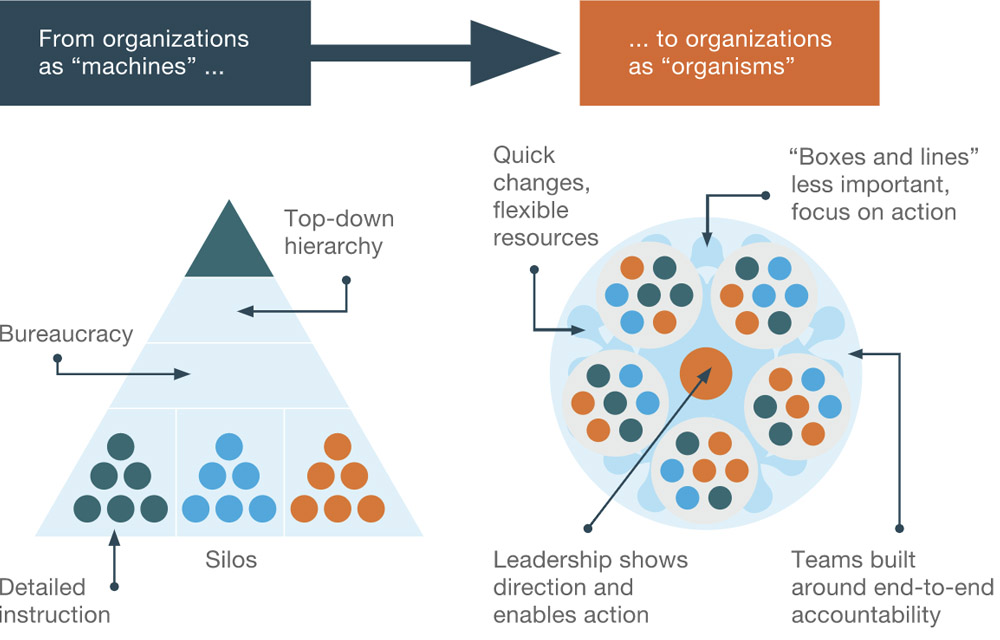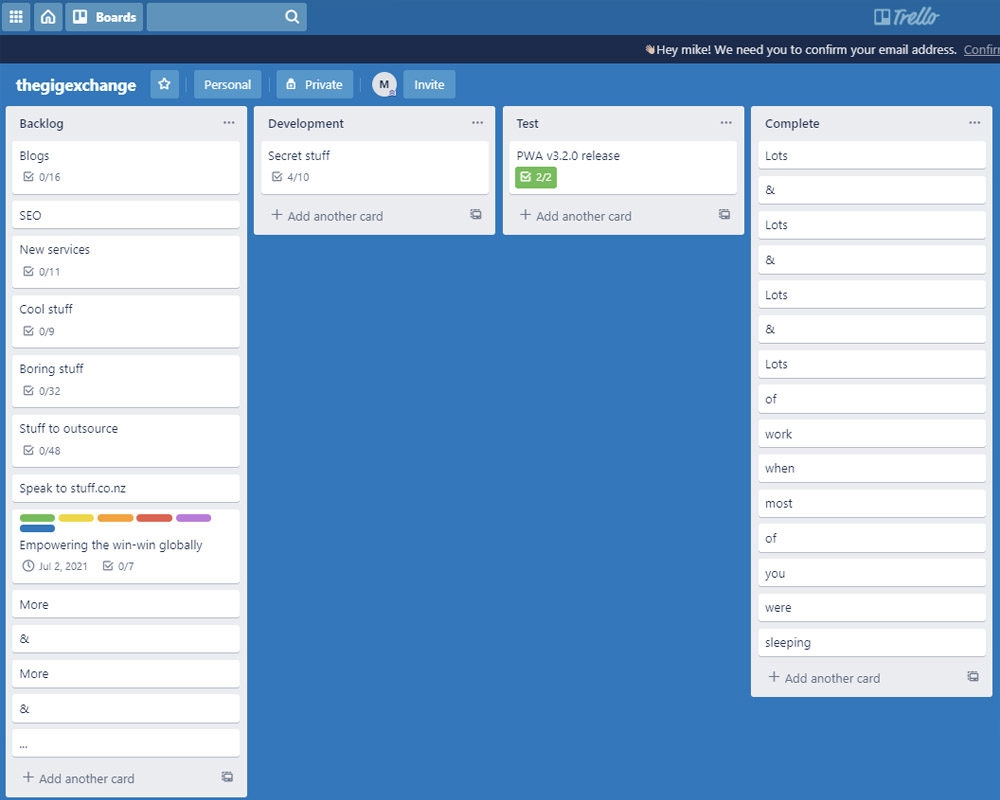
Agile and the Future of Work
The world in which we work is forever evolving. Agile methodologies are being adopted by leading innovative organisations across the globe and within New Zealand to measure and improve internal business and project workflows and outcomes, at speed.
As companies begin to act faster and more flexibly, more and more businesses are questioning traditional project management methods when it comes to delivering faster successful business outcomes. Agile working promises to make companies more dynamic, innovative, collaborative, decisive and consequently, more productive.
So what is agile and how does it work?
Agile methodologies evolved from a manifesto created by a small team to improve the delivery of software products for businesses. This contained a set of values and 12 principles that form the heart of Agile.
Its origin was specifically for software product development, but we are increasingly seeing its adoption across all categories of IT & different business departments.
12 principles of Agile
1. Our highest priority is to satisfy the customer through early and continuous delivery of valuable software.
2. Welcome changing requirements, even late in development. Agile processes harness change for the customer’s competitive advantage.
3. Deliver working software frequently, from a couple of weeks to a couple of months, with a preference to the shorter timescale.
4. Business people and developers must work together daily throughout the project.
5. Build projects around motivated individuals. Give them the environment and support they need, and trust them to get the job done.
6. The most efficient and effective method of conveying information to and within a development team is face-to-face conversation.
7. Working software is the primary measure of progress.
8. Agile processes promote sustainable development. The sponsors, developers, and users should be able to maintain a constant pace indefinitely.
9. Continuous attention to technical excellence and good design enhances agility.
10. Simplicity–the art of maximizing the amount of work not done–is essential.
11. The best architectures, requirements, and designs emerge from self-organizing teams.
12. At regular intervals, the team reflects on how to become more effective, then tunes and adjusts its behaviour accordingly.
How is Agile helping new ways of working as opposed to traditional methods?
These 4 aspects illustrate the difference between agile and traditional
1) Project management
If a project is processed linearly, a project manager is responsible for its success. Often only this person knows about the overall requirements and the schedule and assigns precisely defined work packages to the team members. The project manager monitors the implementation and also creates the environment for the team members to be able to deliver what is required.
For agile methods like Scrum, this role is shared: The product owner is responsible for ensuring that the requirements defined in the product backlog are met. The Scrum master, on the other hand, is not involved in the content of the project. They ensure that the project becomes a success by creating the framework conditions for it. The Scrum Master monitors compliance with the Scrum rules and supports the project team as moderator and coach.
2) Responsibility
In the traditional way of working, only the project manager needs to know the goals. He is the one who bears the responsibility for success and must therefore be able to decide for himself how he wants to achieve the goal.
With agile methods it is necessary that all participants know about the whole project in detail. Scrum and Co. thus shift the responsibility away from management to the development teams. Because if everyone knows the goals and visions, or even has a say in them, then everyone is responsible for their realisation. The team members do not receive fixed work packages, but can decide for themselves how they want to achieve the set goal. Each individual therefore enjoys more personal responsibility.
3) Communication
If a project is implemented in defined phases, communication is more or less limited to the clear instructions of the project manager. The project manager can assign precisely defined work packages to the team members.
Agile approaches, on the other hand, require much more communication. The success of a project depends on whether everyone involved has the same level of information about the goals, the current status quo, progress, hurdles and any changes. With Scrum, for example, this communication flow is given by various fixed meetings: At the Daily Scrum, the team briefly but regularly coordinates what each individual has achieved since the last meeting, what they will achieve by the next meeting and what obstacles could prevent them from doing so. These meetings don't necessarily have to take place on a daily basis. Rather, the project and the framework conditions determine the meaningful rhythm of the meetings. In addition, Scrum also provides for further meetings. At the beginning and end of each sprint, for example.
4) Structure
The traditional way of working requires a clear hierarchical structure of an organization. Each individual has a clearly defined role, which he or she fulfils in the best possible way.
At first glance, agile working methods do not seem to be subject to any structure. But this impression is deceptive. The structure at Scrum & Co. refers less to people and functions, but more to rules of the game and communication. A company must adapt and adapt both to its own needs.
Who uses Agile?
Disruptive start-ups like gigexchange.com use agile methodologies to plan, prioritise and measure delivery of product and marketing campaigns. By measuring success per sprint, or Kanban user stories, Agile methodologies allow businesses to easily pivot and re-prioritise when needed, at speed.
In the case of Covid19, gigexchange launched its product to market 6 weeks before Covid19 became a global pandemic and the world rebooted. This was an unforeseen circumstance for the everyone. But by using Kanban to document and monitor all our backlog tasks and user stories, be that from a software development & business responsibilities boards. We were able to quickly pause our paid marketing operations and pivot to new more productive organic work.
We saw how devastating Covid19 would be on our target business market. So instead of wasting valuable advertising revenue to an audience who were suffering greatly, we quickly re-prioritised our workload to re-prioritise our organic reach, through some technical and content strategy changes we have implemented over lockdown.
The outcome has seen measurably dramatic improvement for key areas we are targeting & huge numbers of new customers, from all across the globe, at no paid cost. When we soon relaunch our paid advertising campaigns, this will substantially help our liquidity to businesses looking for workers, or work tasks completed.
The beauty of Agile allows us to easily revert back to our launch campaign, post pivot (with some slight amendments as a result of the new world we live in) and follow the same processes to plan, deliver, measure, review and iterate.
We love how tech is facilitating completion of work tasks. Especially software collaborative tools like Trello, Azure DevOps etc… here we can document our work tasks accordingly and measure completion parameters. The software means its scalable and repeatable tasks can be replicated and/or modified when applied to similar user stories for slightly different campaigns eg different geographic marketing campaigns or eg on-platform SEO copywriting strategies, per country.
What is the difference between Scrum & Kanban?
Scrum is an iterative, incremental work method that provides a highly prescriptive way in which work gets completed.
Work is broken up into Sprints, or set amounts of time (usually 2-4 weeks) in which a body of work must be completed before the next Sprint can begin.
Sprints are popular in software product development, where dependencies are removed and work tasks are understood and measured to be completed within the sprint timeframe.
Kanban is all about visualizing your work, limiting work in progress, and maximizing efficiency (or flow). Kanban teams focus on reducing the time it takes to take a project (or user story) from start to finish. They do this by using a kanban board and continuously improving their flow of work.
Kanban is great for teams that have lots of incoming requests that vary in priority and size.
Whereas scrum processes require high control over what is in scope, kanban let’s you go with the flow.
Gigexchange is a Kanban fan. Our business has been built with a distributed team, working as a side hustle out of hours when everyone else is sleeping, using digital collaborative tools to plan & monitor workflow as well as send the odd meme... We love Agile!!!
How can we demonstrate and measure if Agile is helping our business work smarter than before?
Big business has always struggled to operate and deliver as fast as its leaders would like. With the digital disruptive era we are living in, the need to evolve and respond to disruption is a hot topic.
McKinsey did a great piece on how companies are changing from organisations as ‘machines’, to ‘organisms’ The below visual highlights the shift in structure, methodology and purpose.
This is due to the ever changing business landscape and a framework for large companies to try and respond, largely to keep up with the ever changing impact of disruptive startups and talent/workers landscape.

How can Agile work for my business in the Future of Work?
Our best advice, understand what you want to achieve. This can be big picture and more specific. Then load up some software to begin quantifying & prioritising your work. We recommend Trello as a starting point. Break down your objectives into tasks and sub-tasks to help you visualise the workload and journey to success. Prioritise what is important to you as well as dependencies. Then the most important step… Get busy doing!!!! Nothing is ever achieved talking about it.

Here at the gigexchange.com we can help you find workers to complete your backlogged tasks that seem like they are forever growing. Be that through using our jobs service helping you to find and hire conventional workers through permanent or contract jobs. Or using our gig economy service to find and hire on-demand freelancers, contractors or gig workers to complete specific outcome based tasks or user stories in your Agile Sprints or Kanban tasks.